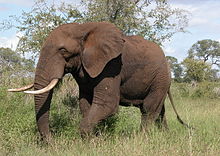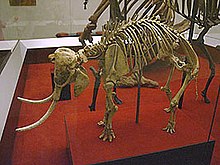
Proboscidea
| Proboscidea | |
|---|---|

| |
| African bush elephant, Loxodonta africana | |

| |
| Skeleton of Moeritherium | |
|
Scientific classification | |
| Kingdom: | Animalia |
| Phylum: | Chordata |
| Class: | Mammalia |
| Clade: | Tethytheria |
| Order: |
Proboscidea Illiger, 1811 |
| Subclades | |
The Proboscidea (/ˌprɒbəˈsɪdiə/; from Latin proboscis, from Ancient Greek προβοσκίς (proboskís) 'elephant's trunk') are a taxonomic order of afrotherian mammals containing one living family (Elephantidae) and several extinct families. First described by J. Illiger in 1811, it encompasses the elephants and their close relatives. From the mid-Miocene onwards, most proboscideans were very large. The largest land mammal of all time may have been a proboscidean; Palaeoloxodon namadicus was up to 5.2 m (17.1 ft) at the shoulder and may have weighed up to 22 t (24.3 short tons), almost double the weight of some sauropods like Diplodocus carnegii. The largest extant proboscidean is the African bush elephant, with a record of size of 4 m (13.1 ft) at the shoulder and 10.4 t (11.5 short tons). In addition to their enormous size, later proboscideans are distinguished by tusks and long, muscular trunks, which were less developed or absent in early proboscideans.
Three species of elephant are currently recognised: the African bush elephant, the African forest elephant, and the Asian elephant. Elephantidae is the only surviving family of the order Proboscidea; extinct members include the mastodons, gomphotheres and stegodonts. The family Elephantidae also contains several extinct groups, including the mammoths and straight-tusked elephants. The distinctive features of proboscideans include a trunk, tusks, and massive legs. Large ear flaps are present in some proboscideans, including elephants. Some also have tough but sensitive skin; others, like the woolly mammoth, have a coat. The trunk is used for breathing, bringing food and water to the mouth, and grasping objects. Tusks, which are derived from the incisor teeth, serve both as weapons and as tools for moving objects and digging. The large ear flaps assist in maintaining a constant body temperature as well as in communication. The pillar-like legs carry their great weight.
Evolution
Over 180 extinct members of Proboscidea have been described. The earliest proboscideans, Eritherium and Phosphatherium are known from the late Paleocene of Africa. The Eocene included Numidotherium, Moeritherium and Barytherium from Africa. These animals were relatively small and some, like Moeritherium and Barytherium were probably amphibious. Later on, genera such as Phiomia and Palaeomastodon arose; the latter likely inhabited more forested areas. Proboscidean diversification changed little during the Oligocene.
A major event in proboscidean evolution was the collision of Afro-Arabia with Eurasia, during the Early Miocene, around 18-19 million years ago allowing proboscideans to disperse from their African homeland across Eurasia, and later, around 16-15 million years ago into North America across the Bering Land Bridge. Proboscidean groups prominent during the Miocene include the deinotheres, along with the more advanced elephantimorphs, including mammutids (mastodons), gomphotheres, amebelodontids (which includes the "shovel tuskers" like Platybelodon), choerolophodontids and stegodontids. Around 10 million years ago, the earliest members of the family Elephantidae emerged in Africa, having originated from gomphotheres. The Late Miocene saw major climactic changes, which resulted in the decline and extinction of many proboscidean groups such as ambelodontids and choerolophodontids. The earliest members of modern genera of Elephantidae appeared during the latest Miocene-early Pliocene around 5 million years ago. The elephantid genera Elephas (which includes the living Asian elephant) and Mammuthus (mammoths) migrated out of Africa during the late Pliocene, around 3.6 to 3.2 million years ago.
| |||||||||||||||||||||||||||||||||||||||||||||
| Proboscidea phylogeny based on morphological and DNA evidence |
Over the course of the Early Pleistocene, all non-elephantid probobscideans outside of the Americas became extinct (including mammutids, gomphotheres and deinotheres), with the exception of Stegodon. Gomphotheres dispersed into South America during this era as part of the Great American interchange, and mammoths migrating into North America around 1.5 million years ago. At the end of the Early Pleistocene, around 800,000 years ago the elephantid genus Palaeoloxodon dispersed outside of Africa, becoming widely distributed in Eurasia. Proboscideans underwent a dramatic decline during the Late Pleistocene, with all remaining non-elephantid proboscideans (including Stegodon, mastodons, and the gomphotheres Cuvieronius and Notiomastodon) and Palaeoloxodon becoming extinct, with mammoths only surviving in relict populations on islands around the Bering Strait into the Holocene, with their latest survival being on Wrangel Island around 4,000 years ago.
Morphology
Proboscideans experienced several evolutionary trends, such as an increase in size, which led to many giant species that stood up to 500 cm (16 ft 5 in) tall. As with other megaherbivores, including the extinct sauropod dinosaurs, the large size of proboscideans likely developed to allow them to survive on vegetation with low nutritional value. Their limbs grew longer and the feet shorter and broader. The feet were originally plantigrade and developed into a digitigrade stance with cushion pads and the sesamoid bone providing support, with this change developing around the common ancestor of Deinotheriidae and Elephantiformes. The skull grew larger, especially the cranium, while the neck shortened to provide better support for the skull. The increase in size led to the development and elongation of the mobile trunk to provide reach. The number of premolars, incisors and canines decreased. The cheek teeth (molars and premolars) became larger and more specialised. In Elephantiformes, the second upper incisor and lower incisor were transformed into ever growing tusks. The molar teeth changed from being replaced vertically as in other mammals to being replaced horizontally in the clade Elephantimorpha. While early Elephantimorpha generally had long jaws with well developed lower tusks/incisors, from the Late Miocene onwards, many groups convergently developed brevirostrine (shortened) lower jaws with vestigial or no lower tusks. Elephantids are distinguished from earlier proboscideans by a major shift in the molar morphology to parallel lophs rather than the cusps of earlier proboscideans, allowing them to become higher crowned (hypsodont) and more efficient in consuming grass.
Dwarfism
Several species of proboscideans lived on islands and experienced insular dwarfism. This occurred primarily during the Pleistocene, when some elephant populations became isolated by fluctuating sea levels, although dwarf elephants did exist earlier in the Pliocene. These elephants likely grew smaller on islands due to a lack of large or viable predator populations and limited resources. By contrast, small mammals such as rodents develop gigantism in these conditions. Dwarf proboscideans are known to have lived in Indonesia, the Channel Islands of California, and several islands of the Mediterranean.
Elephas celebensis of Sulawesi is believed to have descended from Elephas planifrons. Elephas falconeri of Malta and Sicily was only 1 m (3 ft), and had probably evolved from the straight-tusked elephant. Other descendants of the straight-tusked elephant existed in Cyprus. Dwarf elephants of uncertain descent lived in Crete, Cyclades and Dodecanese, while dwarf mammoths are known to have lived in Sardinia. The Columbian mammoth colonised the Channel Islands and evolved into the pygmy mammoth. This species reached a height of 1.2–1.8 m (4–6 ft) and weighed 200–2,000 kg (440–4,410 lb). A population of small woolly mammoths survived on Wrangel Island as recently as 4,000 years ago. After their discovery in 1993, they were considered dwarf mammoths. This classification has been re-evaluated and since the Second International Mammoth Conference in 1999, these animals are no longer considered to be true "dwarf mammoths".
Classification
Below is an unranked taxonomy of proboscidean genera as of 2019.
-
Proboscidea Illiger, 1811
- †Eritherium Gheerbrant, 2009
- †Moeritherium Andrews, 1901
- †Saloumia Tabuce et al., 2019
- †Numidotheriidae Shoshani & Tassy, 1992
- †Phosphatherium Gheerbrant et al., 1996
- †Arcanotherium Delmer, 2009
- †Daouitherium Gheerbrant & Sudre, 2002
- †Numidotherium Mahboubi et al., 1986
- †Barytheriidae Andrews, 1906
- †Omanitherium Seiffert et al., 2012
- †Barytherium Andrews, 1901
- †Deinotheriidae Bonaparte, 1845
- †Chilgatherium Sanders et al., 2004
- †Prodeinotherium Ehik, 1930
- †Deinotherium Kaup, 1829
-
Elephantiformes Tassy, 1988
- †Eritreum Shoshani et al., 2006
- †Hemimastodon Pilgrim, 1912
- †Palaeomastodon Andrews, 1901
- †Phiomia Andrews & Beadnell, 1902
-
Elephantimorpha Tassy & Shoshani, 1997
- †Mammutidae Hay, 1922
- †Losodokodon Rasmussen & Gutierrez, 2009
- †Eozygodon Tassy & Pickford, 1983
- †Zygolophodon Vacek, 1877
- †Sinomammut Mothé et al., 2016
- †Mammut Blumenbach, 1799
-
Elephantida Tassy & Shoshani, 1997
- †Choerolophodontidae Gaziry, 1976
- †Afrochoerodon Pickford, 2001
- †Choerolophodon Schlesinger, 1917
- †Amebelodontidae Barbour, 1927
- †Afromastodon Pickford, 2003
- †Progomphotherium Pickford, 2003
- †Eurybelodon Lambert, 2016
- †Serbelodon Frick, 1933
- †Archaeobelodon Tassy, 1984
- †Protanancus Arambourg, 1945
- †Amebelodon Barbour, 1927
- †Konobelodon Lambert, 1990
- †Torynobelodon Barbour, 1929
- †Aphanobelodon Wang et al., 2016
- †Platybelodon Borissiak, 1928
- †Gomphotheriidae Hay, 1922 (paraphyletic)
- "trilophodont gomphotheres"
- †Gomphotherium Burmeister, 1837
- †Blancotherium May, 2019
- †Gnathabelodon Barbour & Sternberg, 1935
- †Eubelodon Barbour, 1914
- †Stegomastodon Pohlig, 1912
- †Sinomastodon Tobien et al., 1986
- †Notiomastodon Cabrera, 1929
- †Rhynchotherium Falconer, 1868
- †Cuvieronius Osborn, 1923
- "tetralophodont gomphotheres"
- †Anancus Aymard, 1855
- †Paratetralophodon Tassy, 1983
- †Pediolophodon Lambert, 2007
- †Tetralophodon Falconer, 1857
- "trilophodont gomphotheres"
-
Elephantoidea Gray, 1821
- †Stegodontidae Osborn, 1918
- †Stegolophodon Schlesinger, 1917
- †Stegodon Falconer, 1857
-
Elephantidae Gray, 1821
- †Stegotetrabelodontinae Aguirre, 1969
- †Stegodibelodon Coppens, 1972
- †Stegotetrabelodon Petrocchi, 1941
- †Selenotherium Mackaye, Brunet & Tassy, 2005
-
Elephantinae Gray, 1821
- †Primelephas Maglio, 1970
- Loxodonta Anonymous, 1827
- †Palaeoloxodon Matsumoto, 1924
- †Mammuthus Brookes, 1828
- Elephas Linnaeus, 1758
- †Stegotetrabelodontinae Aguirre, 1969
- †Stegodontidae Osborn, 1918
- †Choerolophodontidae Gaziry, 1976
- †Mammutidae Hay, 1922
Bibliography
- Nowak, Ronald M. (1999), Walker's Mammals of the World (6th ed.), Baltimore: Johns Hopkins University Press, ISBN 978-0-8018-5789-8, LCCN 98023686
- Haynes, Gary (1993), Mammoths, Mastodonts, and Elephants: Biology, Behavior and the Fossil Record (2nd ed.), Cambridge University Press, ISBN 9780521456913
- Sukumar, R. (11 September 2003). The Living Elephants: Evolutionary Ecology, Behaviour, and Conservation. Oxford University Press, USA. ISBN 978-0-19-510778-4. OCLC 935260783.
|
Extant mammal orders
| |||||||||||||||||||
|---|---|---|---|---|---|---|---|---|---|---|---|---|---|---|---|---|---|---|---|
| |||||||||||||||||||
| Yinotheria |
|
||||||||||||||||||
| Theria |
|
||||||||||||||||||
| ||
|
Genera of the order Proboscidea
| ||||||||||||||||||||||||||||||||||||||||||||
|---|---|---|---|---|---|---|---|---|---|---|---|---|---|---|---|---|---|---|---|---|---|---|---|---|---|---|---|---|---|---|---|---|---|---|---|---|---|---|---|---|---|---|---|---|
| ||||||||||||||||||||||||||||||||||||||||||||
|
||||||||||||||||||||||||||||||||||||||||||||
|
Extant Proboscidea species by family
| |||||
|---|---|---|---|---|---|
| |||||
|
Elephantidae (Elephants) |
|
||||








